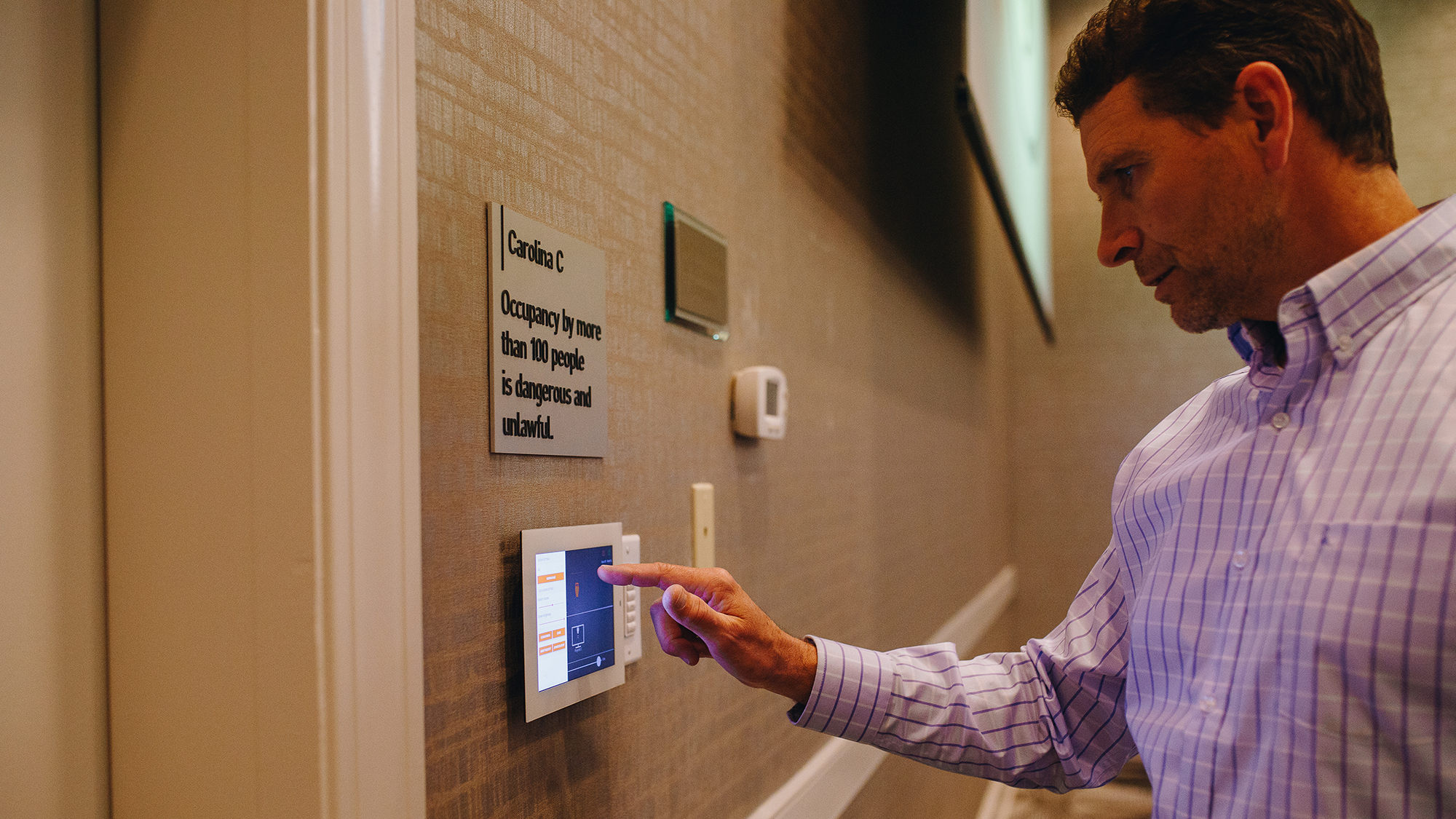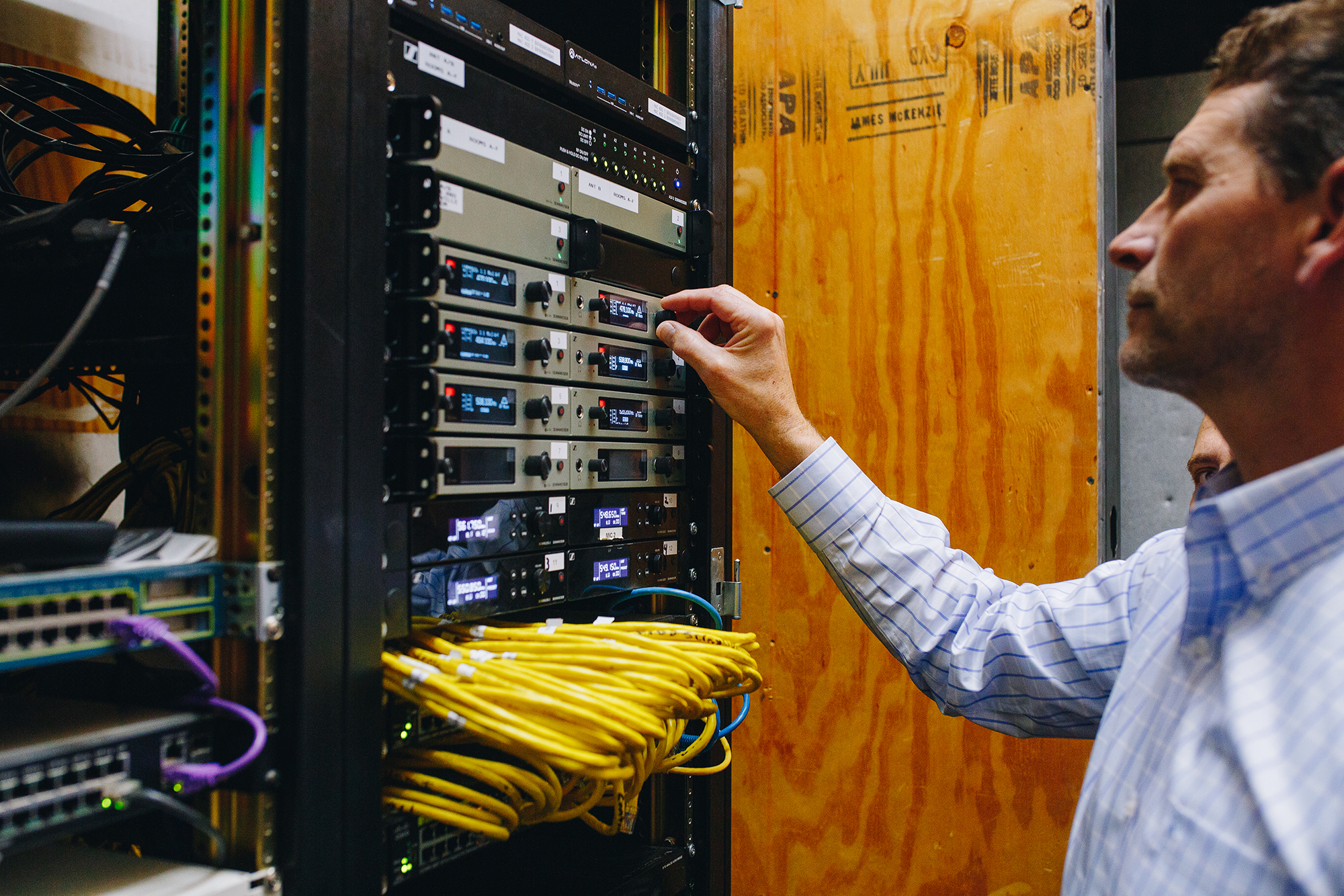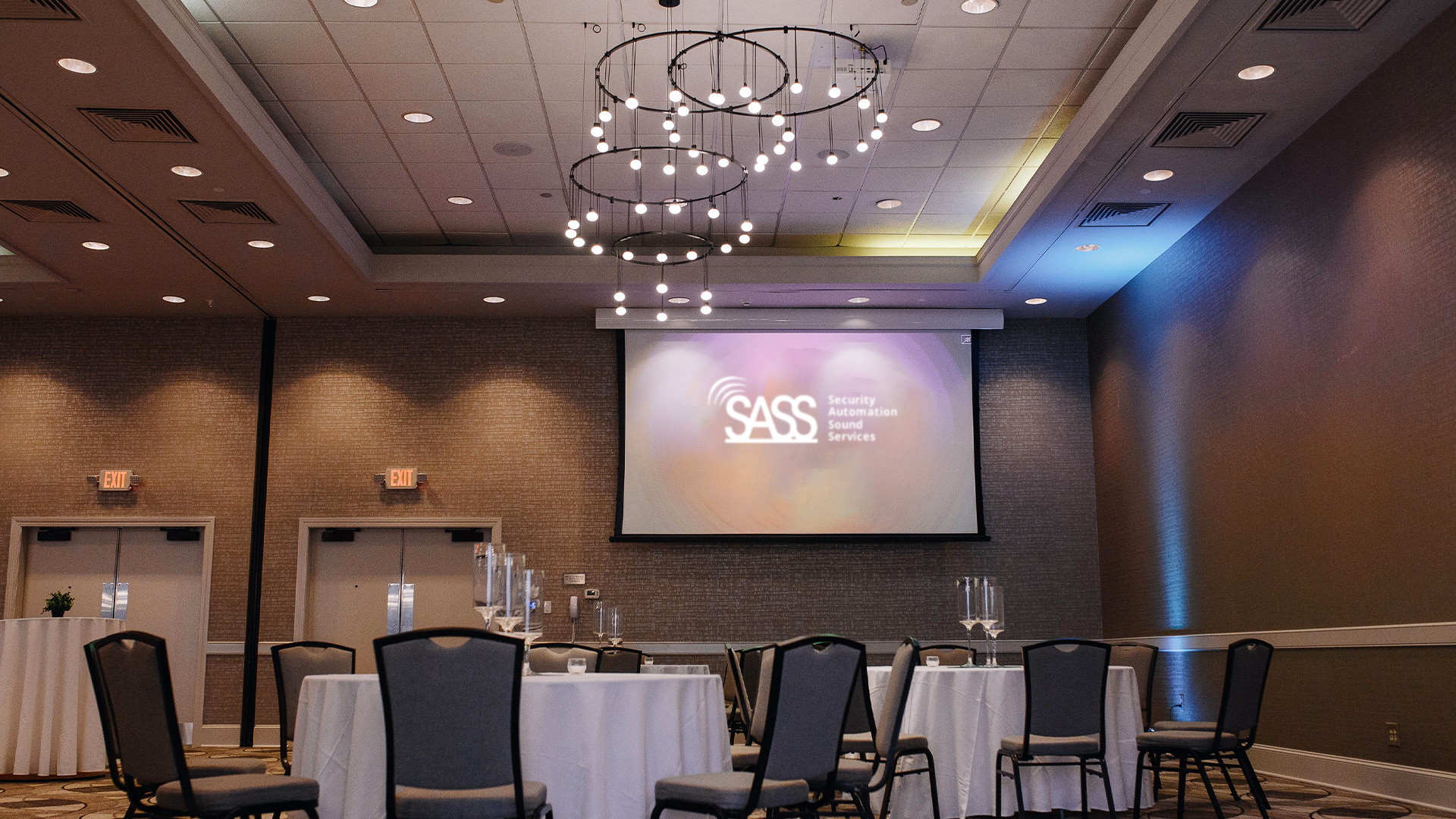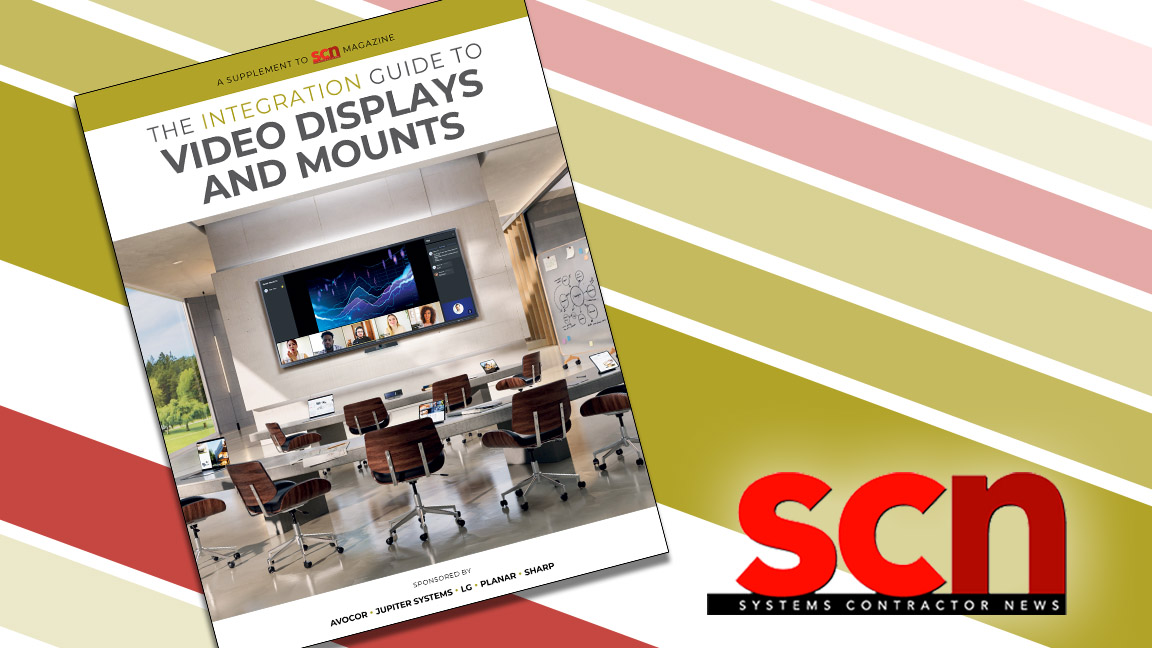SASS Turns to AVoIP to Feed AV Environments at the Hilton Greenville
Tasked with upgrading the audiovisual systems of the divisible ballrooms and conference rooms at the Hilton Greenville, Security Automation Sound Services (SASS) chose to install an Atlona AV over IP solution so they could bring the hotel’s AV control on the network.

Hotel properties often represent a diverse sampling of what’s happening in commercial AV integration. While hotel installations are technically all considered part of the hospitality vertical, specifics of the AV use cases there vary quite a bit between venues, from boutique independent hotels to the largest global chains. A hotel project today will often encompass AV for several different applications, including meeting spaces, convention spaces, leisure activities, dining, retail, and entertainment venues. The possibilities truly seem endless for the systems integrator.
The team at Security Automation Sound Services (SASS) found themselves focused more on the corporate and business side when they began work on the audiovisual integration project at the Hilton Greenville in Greenville, NC. With five meeting rooms and 43,194 square feet of event space, the hotel is a popular destination for corporate gatherings, business meetings, and small conventions, as well as privately hosted events.
The SASS team was tasked with upgrading AV systems in the divisible ballrooms and conference rooms used mainly for these purposes. The existing AV environment was sparse at best. Video was limited to basic projectors, while some audio components could support announcements and simple presentations. A control system had been installed at some point, though it was rarely used and never effectively.
[ Installing AVoIP Systems Today Affords Future Expansion Possibilities ]
“They had a sound board temporarily placed in each space, with some wireless microphones and a single wall-mounted loudspeaker,” said Stephen Gardner, owner and president of SASS. “There were some corporate executives interested in the rooms, which are quite large—and we needed to jump in quickly to put a plan into action.”

A longtime installer of Bose commercial sound systems, Gardner loaned the hotel a small system to improve the audio quality and capabilities while the SASS team began considering the AV infrastructure upgrade. Even with the temporary Bose system in place, audio was stretched to its limits considering the large spaces it worked to fill—which led to an accelerated decision-making process by hotel execs.
[ The Integration Guide to AVoIP ]
A daily selection of the top stories for AV integrators, resellers and consultants. Sign up below.
Gardner quickly set his sights on an AV over IP architecture, given the variety of spaces and the distance between some locations. “We wanted to build one system that could feed all of these different spaces,” he said. “We wanted to establish a flexible input and output strategy that we could easily scale. That’s not really possible with a legacy matrixed system, where you are limited by fixed I/O counts and dedicated endpoints.”
Gardner guided the client toward Atlona’s OmniStream Pro family instead of a more expensive option suggested by another firm. While both solutions offered the flexibility for signal distribution the hotel required—along with the system expandability he sought—OmniStream’s interoperability with Gardner’s audio choices was significant.
There was one other factor in OmniStream’s favor: Gardner had his eye on bringing the hotel’s AV control on the network, which he could most easily achieve with Atlona’s Velocity IP-enabled control platform.
“I come from the analog world, but the AV universe is all rapidly moving to IP,” said Gardner. “We don’t want our end users to be stuck. OmniStream and Velocity together offered Hilton Greenville the best of both worlds for a genuine AV over IP environment.”
[ What's the Status of the AV over IP Transition? ]
Simplified Programming
Gardner stressed that Atlona’s professional programming environments ultimately helped him bring together a very complex AV distribution architecture.
“There was very intense programming when it came to building this system, and I don’t think I’m overstating it when I say we pushed the envelope,” Gardner said. “In the hotel’s West Wing alone, we accommodated microphone and video feeds in three spaces that can be divisible into four, five, or six rooms depending on what is happening in the hotel. We’re also feeding endpoints in the Greenville Room, which is a more upscale room for small conferences, and then there are four rooms on the other side of the hotel.”

Gardner noted that Atlona has established a “click-and-play” system that is easy to use. While he pushed the envelope on the programming side, he said Atlona’s environment made the process easy to manage overall. Most importantly, the system is doing what the previous one could not, even for audio alone.
[ AVoIP and the Meeting Space ]
“There are partitions in each of West Wing ballrooms, and they could never take advantage of pushing unique content to divisible spaces,” Gardner said of the legacy system. “The existing control system was supposed to accommodate that, but it was difficult for the end user to comprehend. Ultimately it sat there mostly unused.”
“Velocity changes everything on the control side when it comes to ease of use,” Gardner continued. “If it’s a single room, we’re just worried about master volume on the touch panel. And when they link the rooms, they can easily pull in HDMI video feeds and direct them to two or more spaces. Velocity keeps the complex very simple.”
Network Convergence
The OmniStream Pro architecture includes a mix of OmniStream 111 WP Wallplate networked AV encoders, OmniStream 121 (single-channel) and 122 (dual-channel) networked AV decoders, and OmniStream 238 IP-to-analog audio bridge devices. The SASS team installed two wall plates in each of the six West Wing divisible spaces—one in the front of the room and one in the back—and one in the Greenville Room, with a second in storage if needed. Front and back wall plates were installed in the four remaining rooms on the other side of the hotel.
The team added OmniStream decoders in a variety of locations to better suit delivery to endpoints, which included Epson Cinema 660 projectors and Screen Innovations 160-inch screens. Some were installed in ceilings near Epson projectors, and others within an existing 42U equipment rack that was rewired and reused for this project. The IT-friendly rack also integrates two 48-port Cisco network switches and all pertinent audio equipment, including the OmniStream 238, a Bose ControlSpace EX-1280C DSP, and a Sennheiser EW 500 G4Series wireless antenna system.
OmniStream’s integration with the ControlSpace EX-1280C DSP was especially critical to execute Gardner’s vision, which would include Bose loudspeakers.
“Bose uses Dante exclusively. Before we brought in OmniStream, it would not talk to the existing AES audio streams moving through the spaces,” said Gardner. “Now, the OmniStream 238 brings the audio signals into the Bose, which has a 64x64 I/O capacity.”
The DSP moves the audio to Bose FreeSpace DS 100F loudspeaker systems, which were deployed in a 70-volt configuration to accommodate the longer runs.
“The FreeSpace system replaced these enormous wedge-shaped speakers that were just cancelling each other out because of how they were spaced and positioned,” said Gardner. “The audio integrity is now perfect for these spaces.”
The Sennheiser system improves presentation audio. Configured as a redundant A/B system, the wireless Sennheiser solution includes high-quality handheld microphones and a mix of single- and dual-channel receivers. A distribution amplifier in the rack brings in the various antennas from the system’s power amplifier.
Gardner noted that Atlona, Bose, and Sennheiser all worked closely with him and his team to customize the system and provide the flexible programming environments he needed. He also had high praise for Screen Innovations, noting that the company made the installation easier by eliminating the need for flush-mounting screens.
“We really had to think through the programming. We couldn’t simply cut-and-paste the same setting for every space because each was unique,” Gardner concluded. “This was especially true when it came to the HDMI video feeds, the microphone system, and the DSP flows. These companies made a very challenging programming and integration project a lot more seamless than it could have been.”
Click here to read more stories from the September 2021 issue of SCN.
Related Stories
AV-over-IP Workflows Suitable for Applications of All Sizes • The AV-over-IP revolution isn’t just transforming the way organizations send signals across buildings and campuses; it’s changing the landscape of the broadcast industry as well.
Product Review: Atlona OmniStream 112/121 AV over IP Solutions • Jeremy Caldera looks at an Atlona AV over IP solution, testing how the Atlona OmniStream 112 networked AV encoder and 121 decoder transmit high-quality 4K video over gigabit Ethernet infrastructure.
What's the Status of the AV over IP Transition? • Manufacturers discuss the transition to AV over IP networks and their company’s place in the shift.
Optimizing AV over IP in Corporate Network Installations • Thanks to scalability, flexibility, and ease of deployment and management, AV over IP continues to gain popularity among integrators and tech managers in corporate environments, according to Atlona’s Seth Powell.
1Gb vs. 10Gb Ethernet: Which Is Right for Your AV Network? • Which gigabit Ethernet network should be the standard for AV over IP? Leading manufacturers of networked AV solutions told us what they think.
